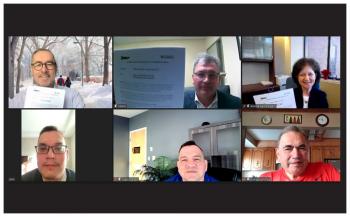Image Caption
Summary
Local Journalism Initiative Reporter
Windspeaker.com
The need for more Indigenous doctors and improvements to health care in their communities has led to six First Nations forming a new partnership with the University of Alberta.
An historic memorandum of relational understanding was signed on Dec. 15 by the U of A and Tribal Chiefs Ventures Inc., which represents Beaver Lake Cree Nation, Cold Lake First Nation, Frog Lake First Nation, Heart Lake First Nation, Kehewin Cree Nation, and Whitefish Lake First Nation No. 128, all located in northeastern Alberta.
The agreement was signed on the sixth anniversary of the release of the 94 Calls to Action by the Truth and Reconciliation Commission.
Wayne Clark is the executive director of the U of A’s Indigenous Health Initiatives Program, which was founded in 1988 by the Faculty of Medicine and Dentistry with the goal of increasing the number of Indigenous students in medicine and dentistry programs.
Clark said the new partnership came about when he was referred to Chief Cameron Alexis of Tribal Chiefs Ventures.
Alexis told Windspeaker.com that when the Elders met to talk about health care, they were concerned about not seeing enough Indigenous doctors and nurses.
“They said ‘every time we go to the doctors, we don’t see our people working there.’ That’s why the chiefs and I came together to start working with the University of Alberta. We sat down and said we have to do something better. And this is how our discussions began.”
The discussions focused on what steps were needed to move First Nations young people into meaningful health care careers.
“There is a need for Indigenous medical practitioners — physicians, psychologists, psychiatrists, nurse practitioners, RNs, dentists and others — to help address the needs of First Nations peoples,” Alexis said in a press statement.
The partnership is the first of its kind undertaken by the U of A. There are three areas that will be worked on, starting with the recruitment of more Indigenous medical school applicants.
“Throughout my travels, one thing I’ve always observed is there's very little recruitment from the main institutions across Turtle Island, meaning Canada, in terms of trying to bring our young people into accredited universities,” Alexis said.
“My message is very clear: Our young people can do it too. Our people want to contribute to society. They want to have career paths and they want to go back and serve, not only our nations, but also fellow Albertans, Canadians and even internationally,” said Alexis.
“I’ve heard people say when you are applying for med school you have to be like Mother Teresa and Einstein to have those prerequisites,” said Clark. “So, what we can do with Indigenous students is help support them so they can have those prerequisites and when they are ready to apply, coaching them on what they’re going to need to go through to get through that admissions process because it’s quite rigorous, especially for a young person.”
The program has an intake of 20 students each year. Clark said even increasing that to 30 students would be great. But “sometimes it’s not for lack of spots available,” Clark said.
The second target area is curriculum development in the classroom and experiential learning in the communities.
“A lot of times physicians are trained to work in this biomedical model based on a Western point of view, so the Indigenous worldview is almost cut out of that,” Clark said. “So, the physicians have to reprogram themselves to understand what those socioeconomic determinants of health are [as opposed to] seeing some of the challenges community members experience are their own fault. It’s not their fault. It’s a result of the lack of accessibility.”
And the third focus is on innovative educational solutions to health-care gaps with Indigenous peoples. The program includes training around cultural sensitivity and anti-racism, as well as recognizing the value of traditional healing. Clark says they are looking at ways to train physicians to understand how to close gaps in health outcomes and work within both the federal and provincial systems.
Fine-tuning the memorandum is underway, but all parties are hopeful it will be in place by fall semester 2022.
Local Journalism Initiative Reporters are supported by a financial contribution made by the Government of Canada.

